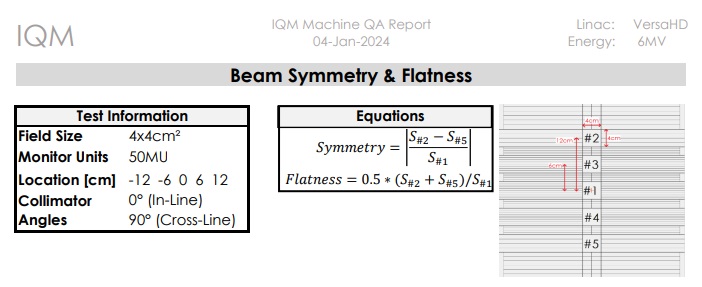The Multi-Center Study “Feasibility of using IQM for QA tests of a medical linear accelerator” published by JACMP in January 2024 brought together Medical Physicists from Princess Margaret Cancer Centre in Toronto, Mayo Clinic in Rochester, and Cedars Sinai Medical Center in Los Angeles to assess IQM’s suitability for Machine QA.
Specific test fields were developed to measure beam symmetry and beam flatness with IQM. The functionality of these test fields for beam symmetry and beam flatness were evaluated by deliberately varying symmetry and flatness values of different energies. Additionally, all beam symmetry and beam flatness measurements were measured with a waterphantom system using CC13 Ion chambers.
The beam symmetry results of the IQM system were compared to those of the linac beam monitoring chamber as well as to the subsequent waterphantom scans. The results suggest that IQM has a highly linear response to beam symmetry variations of the linac monitoring chamber as well as to the symmetry measurements using a waterphantom. The resulting sensitivity factors can be used to set appropriate tolerances around the IQM beam symmetry measurements.
The beam flatness results were compared against the beam flatness measured in a water phantom. A linear correlation was found between the IQM flatness measurements and the beam flatness measurements with the waterphantom system, which suggests that tolerances defined for the beam flatness measurements with the IQM system will satisfy the clinical protocols followed by radiotherapy centers all over the world.
The upcoming IQM software release v1.10 embeds completely automated beam symmetry and beam flatness checks into your daily clinical workflow. Pre-defined beam sequences for both beam symmetry and beam flatness measurements are stored in your Oncology Information System and delivered whenever needed.

When the predefined sequence is delivered, without any explicit user action, IQM fully automatically analyses the measured signal data and provides the resulting beam symmetry and beam flatness analysis in a comprehensive report.
The new IQM Beam Symmetry & Flatness Report provides detailed information about the current result, showing the in-line and cross-line maximum deviation of today’s measurements, the resulting in-line and cross-line profiles and the average variations of last month’s symmetry and flatness measurements.

The report also shows the long-term variations (for a user definable time period) for the beam symmetry in both in-line and cross-line directions and illustrates whether these variations are within the user-defined acceptance criteria.

Similarly, the report also shows the long-term variations (for a user definable time period) for the beam flatness in both in-line and cross-line directions and illustrates whether these variations are within the user-defined acceptance criteria.

The Integral Quality Monitor (IQM) system presents an innovative approach to integrate these usually tedious and time-consuming beam symmetry and flatness checks into the daily clinical workflow.
IQM’s fully automated data collection and analysis process significantly reduces the manual effort typically required for this routine check. This full automation provides highly reliable QA outcomes while saving valuable time for medical physicists and other staff involved in QA processes. By integrating QA processes seamlessly into the daily clinical workflow, IQM allows medical physicists to allocate more time to other critical tasks, significantly increasing the overall workflow efficiency of the radiation therapy department and enabling beam symmetry and flatness checks to be performed systematically.
The long-term tracking of linac performance provides ongoing monitoring data and proactive maintenance. Long-term tracking with IQM helps in identifying gradual changes in the machine’s performance over time, serving as bases for planning equipment calibration, upgrades, and replacements.
In summary, the use of an IQM system enhances the overall quality and safety of radiation therapy treatments by providing real-time, accurate, and consistent monitoring of critical beam parameters. This not only helps in delivering effective treatments but also streamlines operations and enhances patient outcomes treatments.
